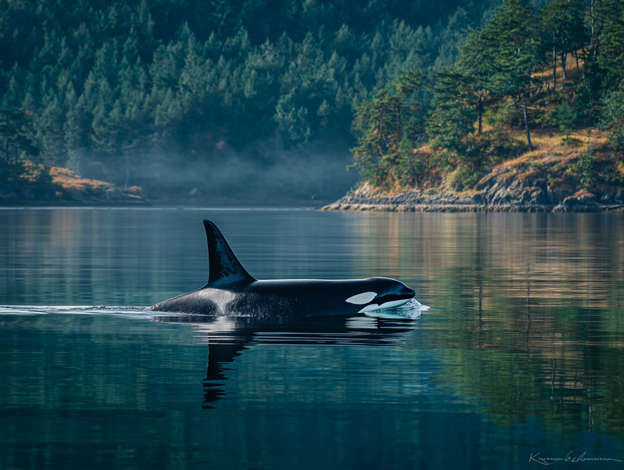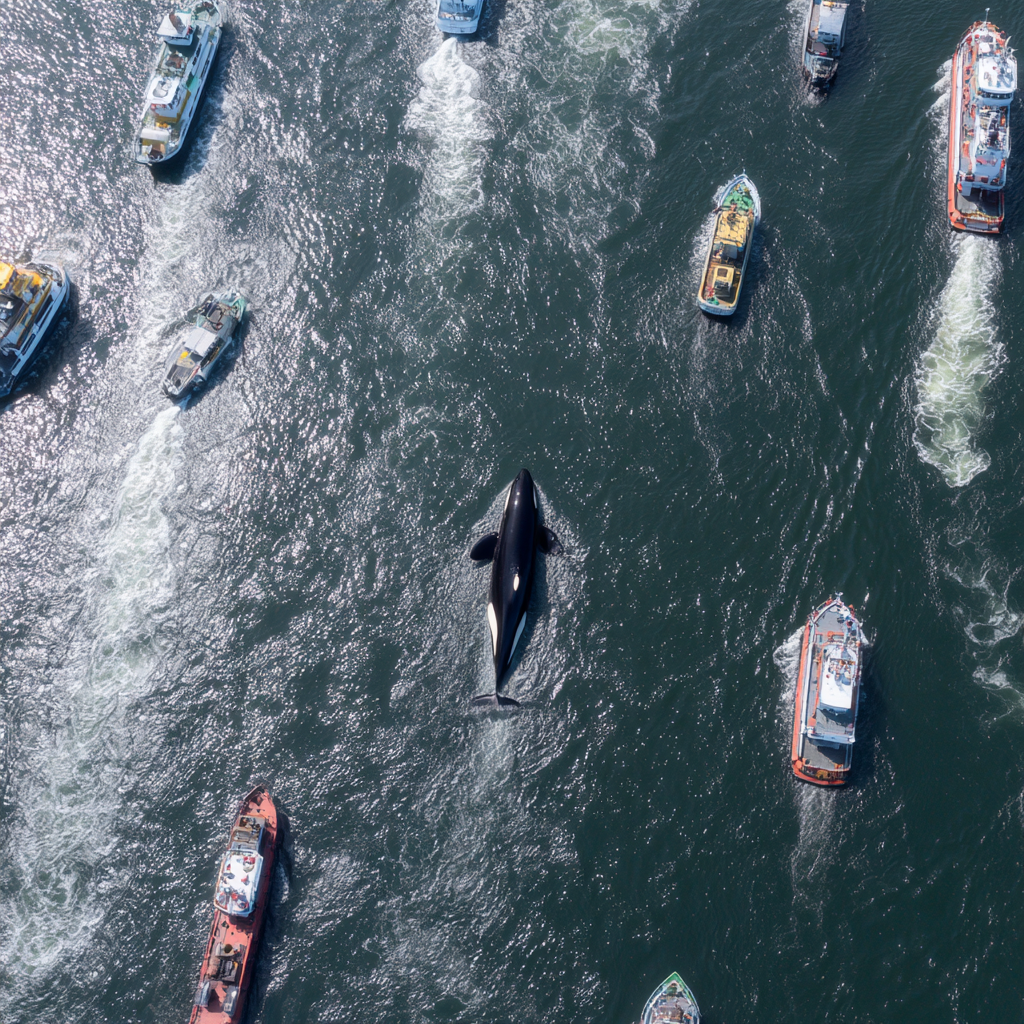
Biological Snapshot
Physical Characteristics
As orcas, they have the characteristic black-and-white patterning. Their saddle patch (the gray area behind the dorsal fin) is often "open," meaning it contains some black coloration, which can help distinguish them from other ecotypes. They have a more rounded dorsal fin tip compared to the sharper point of Bigg's (Transient) killer whales.
Distribution & Habitat
Their core habitat is the Salish Sea, including the Puget Sound, the Strait of Georgia, and the Strait of Juan de Fuca. They are often present in these inland waters from late spring to fall, and their range extends along the outer coast from central California to Southeast Alaska.
Diet & Foraging
A highly specialized diet, feeding almost exclusively on Chinook salmon. They rely heavily on this single species, which makes them extremely vulnerable to fluctuations in salmon populations. They use sophisticated echolocation to hunt and often cooperate to corral fish.

Ancient Kinship: The People Who Live Under the Sea
For the Coast Salish peoples, the Orcas of the Salish Sea are not simply intelligent animals. They are sovereign beings who inhabit a parallel world beneath the waves. The Lummi Nation calls them Sk'aliCh'elh-tenaut, which translates to "the people who live under the sea." In these traditions, Orcas are seen as relatives, possessing their own language, culture, and deep sense of family. Stories tell of chiefs who live in underwater villages and of transformations where humans and Orcas can cross the threshold between their worlds.
This worldview establishes a profound sense of kinship and a responsibility to treat the Orcas with the same respect afforded to a human leader or elder. It is a relationship built not on dominion, but on mutual recognition and reciprocity.
A Modern Grief: The Tour of Tahlequah
In the summer of 2018, this ancient story of kinship was brought to life for the entire world in a heartbreaking, modern ritual of grief. A 20-year-old female from J pod, known to researchers as Tahlequah (J35), gave birth to a female calf. The calf lived for only half an hour.
Instead of abandoning the body, Tahlequah began what scientists called a "tour of grief." She balanced her dead daughter on her head, carrying the body with her as she swam. Day after day, she refused to let go, persistently lifting the calf back up whenever it slipped from her grasp. She carried her daughter's body for 17 days, traveling over 1,000 miles with the rest of her grieving pod.
This unprecedented display of grief resonated globally. It was not an abstract scientific observation; it was a raw, undeniable expression of maternal love and loss. For the Coast Salish, it was a familiar story—the sorrow of a relative for her lost child. For the wider world, it was a profound and shocking revelation. Tahlequah's journey became a powerful symbol of the Southern Residents' plight, transforming the abstract data of their decline into a deeply personal and emotional tragedy. She was no longer just a whale; she was a grieving mother, and her vigil was a protest against the conditions that led to her loss.
The Struggle of the Salmon People
The core struggle of the Southern Resident Orcas is the collapse of their primary food source: Chinook salmon. Their fate is inextricably linked to the fate of the salmon, and the salmon are disappearing.
| Threat | Impact |
|---|---|
| Prey Depletion | The single greatest threat. Overfishing, habitat loss from development, and the damming of major rivers like the Snake and Columbia have decimated the populations of Chinook salmon. Without enough food, the orcas suffer from malnutrition, which leads to failed pregnancies and a high rate of calf mortality. |
| Toxic Contamination | As apex predators, the Southern Residents accumulate high levels of industrial pollutants (like PCBs) and pesticides in their blubber. When they starve, their bodies metabolize this fat, releasing the toxins into their bloodstream. This suppresses their immune systems, damages their organs, and further harms their reproductive capabilities. These toxins are also passed from mother to calf through her milk. |
| Vessel Noise and Disturbance | The Salish Sea is a busy waterway. The underwater noise from commercial ships, ferries, and whale-watching boats can interfere with the orcas' ability to use echolocation to find their already scarce prey. The presence of boats can also disrupt their natural foraging and resting behaviors. |

The story of the Southern Residents is a story of kinship pushed to its breaking point. Their struggle is a direct reflection of the health of the entire Salish Sea ecosystem. As threshold guardians, their message is clear: a world that can no longer support its salmon will not long support its orcas, and a world that loses its orcas loses a profound part of its spirit.
References
- Animal Behaviour - The social dynamics of southern resident killer whales and conservation implications for this endangered population
- PLOS ONE - Endangered predators and endangered prey: Seasonal diet of Southern Resident killer whales
- Scientific Reports - Evaluating anthropogenic threats to endangered killer whales to inform effective recovery plans
- PeerJ - 2018–2022 Southern Resident killer whale presence in the Salish Sea: continued shifts in habitat usage
- National Geographic - Orca Mother Drops Calf, After Unprecedented 17 Days of Mourning
- National Geographic - This orca is carrying around another dead calf: How orcas grieve
- Encyclopedia of Puget Sound - Four years after Tahlequah's journey: The legal and ethical debates over orca protection
- Grist - One stolen whale, the web of life, and our collective healing: Lummi Nation perspective on Sk'aliCh'elh-tenaut
- Center for Whale Research - Southern Resident killer whales: Long-term monitoring and research
- Marine Mammal Commission - Southern Resident Killer Whale conservation status and threats
- NOAA Fisheries - Southern Resident Killer Whale: Endangered Species Conservation
- Parks Canada - Southern Resident Killer Whale science and conservation program